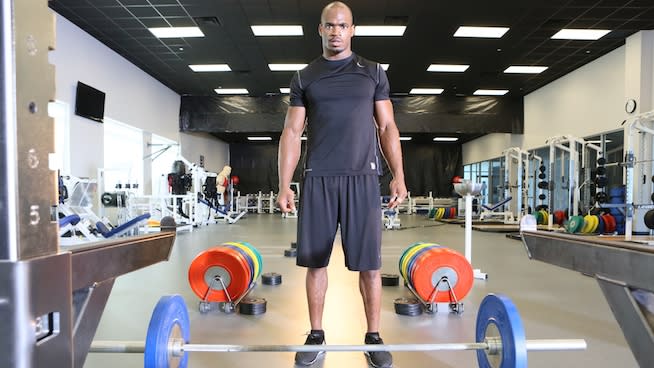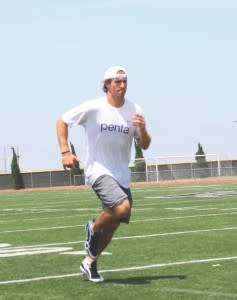6 Things Football Players Must Do to Get Better This Off-Season

How well you manage the next few months will determine your success on the football field next fall. You've heard it before and you'll hear it again: championships are won in the off-season. Your early-morning lifts and afternoon speed sessions will lay the foundation for victory next season, and every little edge you can gain between now and two-a-days will be crucial to your development as an athlete.
Whether you're looking to make varsity, earn a starting spot or solidify a scholarship offer next season, STACK has the info and advice you need. After polling some of the nation's most respected coaches, training experts and NFL players, we've compiled a go-to guide to hitting your off-season goals and dominating the gridiron next fall.
1. Set Goals
New Orleans Saints tight end Benjamin Watson says, “A football player at any level must set goals. Goals give you a mark to shoot for and keep you motivated when you face adversity.”

Saints tight end Benjamin Watson is an 11-year NFL veteran.
His goal of playing college football was what drove Watson to train twice a day and run sprints during the dog days of summer. “My goals in football helped made me disciplined and focused in all areas of my life,” says Watson, who played for the Georgia Bulldogs and was selected in the first round of the 2004 NFL Draft.
WATCH: video of Watson's off-season workouts.
Ron McKeefery, director of sports performance at Eastern Michigan University, says, “All the training in the world won’t do a thing unless it is directed and held accountable by setting short and long-term goals. Therefore, setting clear goals and expectations while simultaneously educating yourself on how best to achieve them must be the foundation of the off-season program.”
McKeefery recommends writing down your plan of action and posting it on the mirror in your bedroom or bathroom. “You are to self-assess every time you look at that paper,” he says.
Follow Watson’s three-step plan for setting and achieving your goals this off-season:
Take time to think about why you want to play the game of football. Is it for fun, exercise, to earn a scholarship or to stay busy? Be honest with yourself and don’t neglect what you want to accomplish because you think it’s unattainable.
Write it down or mark it in your mind. Some people like to write goals down, others can simply put their goals on a billboard in their mind. Do what works for you.
When you train, eat and sleep, always remember the "why" of what you are doing. It may take sacrifice in one area or another of your social life, but be willing to count the cost.
What if you fail to reach a short-term goal or an unforeseen circumstance throws a wrench into your plan of action? According to elite performance coach Mark Roozen, one of the most important elements of goal-setting is the ability to adjust on the fly. Roozen says, “It’s just like taking a trip in a car. If you hit a roadblock or rough patch on the road, you don’t just stop—you re-route how you get there and work to get to the same destination.”
2. Recover
The number one off-season priority for football players is to get healthy, says Kurt Hester, director of strength and conditioning at Louisiana Tech.

Jadeveon Clowney foam rolls his back
Hester says, “Even if you didn't suffer any major injuries, every athlete has muscle imbalances and joint alignment issues. If these problems are not taken care of before you embark on your off-season training program, they will rear their ugly head and develop into serious problems down the line during training.”
Keith Scott, owner of Impact Training & Fitness in South Jersey, recommends soft-tissue work in the form of foam rolling. He says, “Foam rolling every day, active stretching and mobility work are a must, as well as resetting the body with joint-friendly movements.”
Hester adds, “This is not the most exciting type of work and is somewhat tedious at times, but the benefit of training pain-free and reaching your training potential is immense.” (Discover the best exercises for improving joint mobility.)
WATCH: STACK's Elite Performance video series, featuring training expert Mike Boyle, to learn about three exercises for increasing your hip mobility. Boyle also demonstrates how to improve your shoulder mobility by performing Floor Slides.
3. Enhance Functional Range of Motion
Dana Santas, founder and creator of Yoga Radius Conditioning, advises football players to enhance their functional range of motion during the off-season, specifically targeting their hips and mid-back. She says, “From a performance standpoint, increasing mobility in these areas will increase the ability to rapidly change directions, which is a benefit for any position in football.”
Santas recommends integrating three to five yoga postures and movements into football players' off-season training program. For example, Deep Lunges and Straddles with mid-back twisting movements can be used as warm-ups or active rest between sets of complementary functional training exercises.
RELATED: Discover All-Pro CB Patrick Peterson's yoga routine.
At the end of your workout, try adding deep stretches such as the Frog and Pigeon poses to create a truly functional range of motion. Check out the "10 Best Yoga Poses For Athletes" to learn how to perform these movements.
4. Train Speed and Agility

Drew Brees trains speed in the off-season.
Todd Durkin, owner and operator of Fitness Quest 10 in San Diego, says that football players must work on speed—not just strength—in the off-season. “A lot of athletes just focus on getting stronger in the weight room and neglect the actual movement portion of training, including both linear speed and change of directions,” says Durkin, who trains Super Bowl winning QBs Drew Brees and Aaron Rodgers.
WATCH: Video of Durkin demonstrating the best exercise to improve agility.
At the Performance Compound (Tampa, Fla.), the number one off-season training goal for the NFL players is to maximize their speed and agility, according to performance director Jason Riley, who says, “Muscles should fire in a specific sequence, and when you can train the body to hold these patterns, you will be successful in developing speed and decreasing injury potential at the same time.”
To maximize your speed potential, you must learn and master the principles of force application, including:
Applying greater force
Applying force in less time
Applying force in the proper direction
Applying force through a full range of motion
Riley says, “Speed is a skill and can be taught. Here are the drills that have helped players such as Alshon Jeffery, Jairus Byrd and Sammy Watkins maximize their genetic speed potential:
Falling Starts: x5
Speed Bounding: 3x3 each leg
Sled Drags: x4
5. Add Lean Muscle
The best thing a football player can do is put on 7 to 10 pounds of lean muscle and drop three percent body fat, according to Scot Prohaska, strength coach for nationally ranked Mater Dei High School (Calif.) football team.
“Lean muscle is the engine behind power and speed,” says Prohaska, who trains top NFL Draft prospect, Blake Bortles.
How do you pack on lean muscle? Prohaska prescribes a three-step routine:
Train with weights four days per week (discover Prohaska’s Barbell Complex)
Meet your protein needs (1g of protein per pound of bodyweight)
Observe the "Big Boy at Night/Big Boy in the Morning" Rule. If you go out with your friends at night, get up in the morning and get your work in. Nothing gets in the way of workouts.
Todd Durkin, founder of Fitness Quest 10, also stresses the importance of dialing in on your nutritional needs. He says, “Eat breakfast, eat five meals per day, have a snack 60 to 90 minutes prior to working out and [another] within 30 minutes post-workout, [including] lean sources of protein, complex carbs and healthy fats.”
6. Improve Explosiveness and Football-Specific Movements
Chip Smith, owner of Chip Smith Performance Systems, says, “Football players must identify specific movements that translate directly to their position, and work to become more consistently explosive in those movements.”
For example, a quarterback must work on his three- and five-step drops with a focus on being explosive with the first step under center before hitting his third and fifth steps quickly and efficiently. For a cornerback, it means training to explode out of his backpedal and into his break to cover his receiver.
What’s the best way to improve your explosive power? Take it from Travelle Gaines, owner and operator of Athletics Gaines in Los Angeles. He advocates Box Jumps, a plyometric exercise he claims is “guaranteed to add explosiveness to your game on the field in the fall.”
Try this Box Jump routine, used by All-Pro RB Jamaal Charles and 2013 NFL rushing leader LeSean McCoy during their off-season workouts at Gaines Athletics:
Monday: 3x5 Box Jumps using a 24"-42'' box
Wednesday: 3x5 Single-Leg Box Jumps using an 18"-30" box
Friday: 3x5 Speed Plyo Box Jumps using an 18" -36" box

